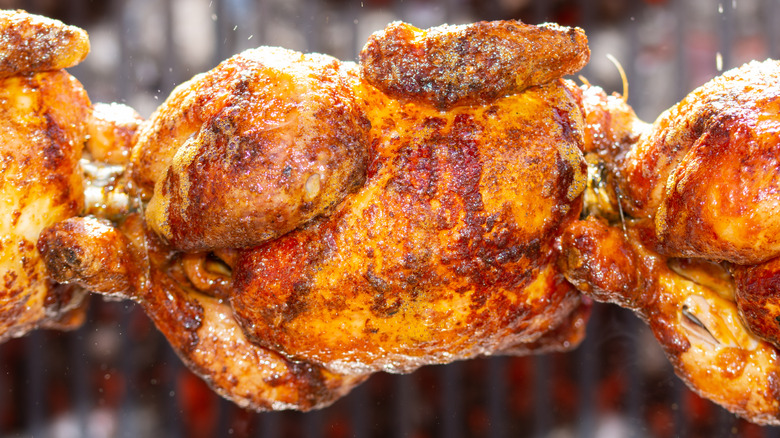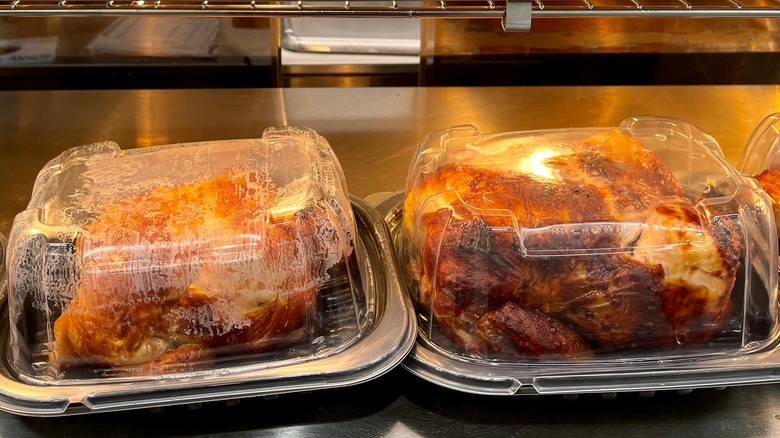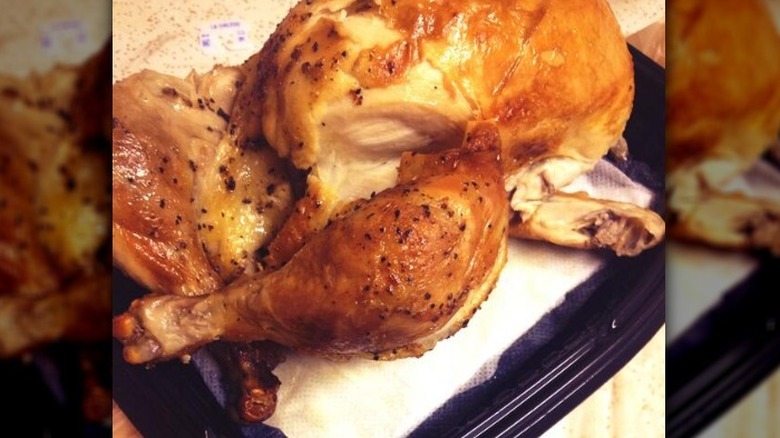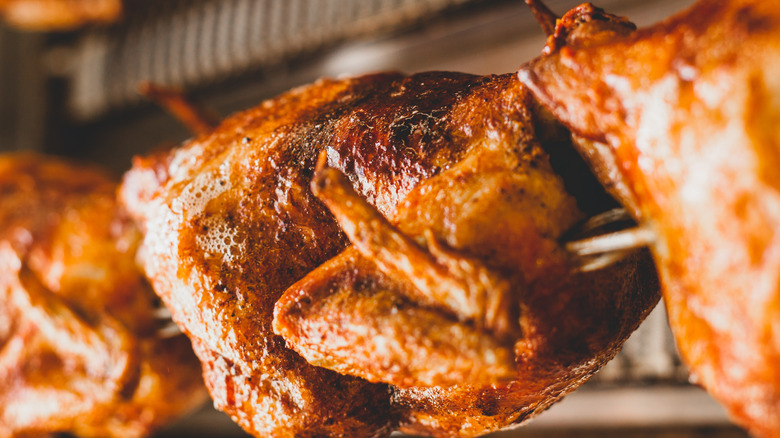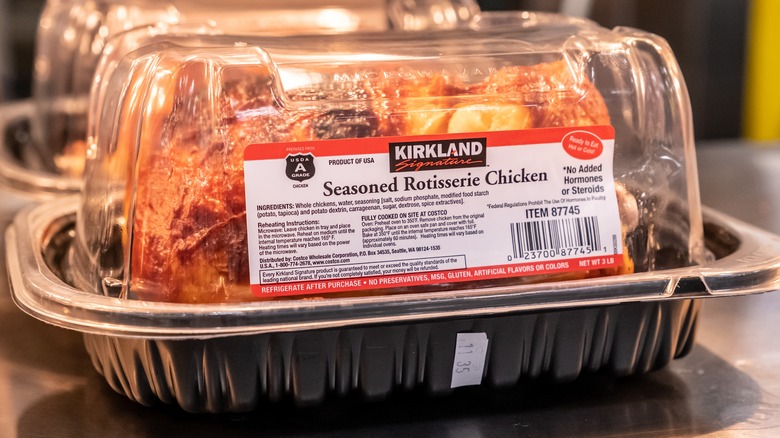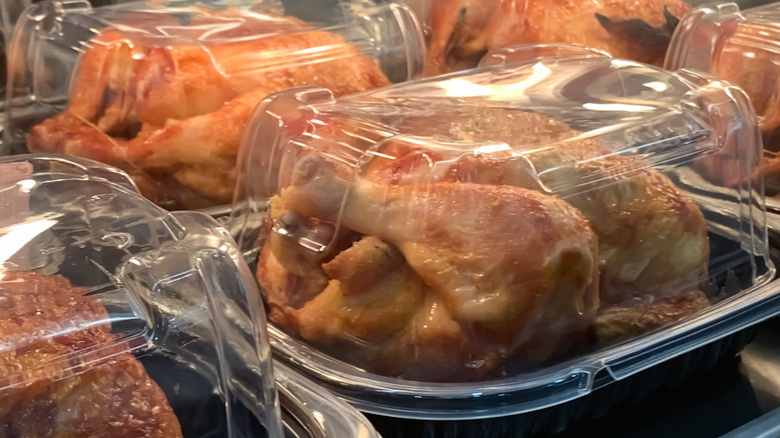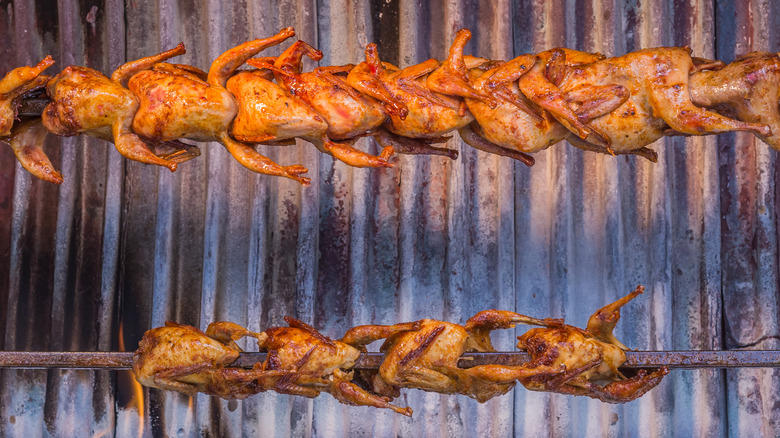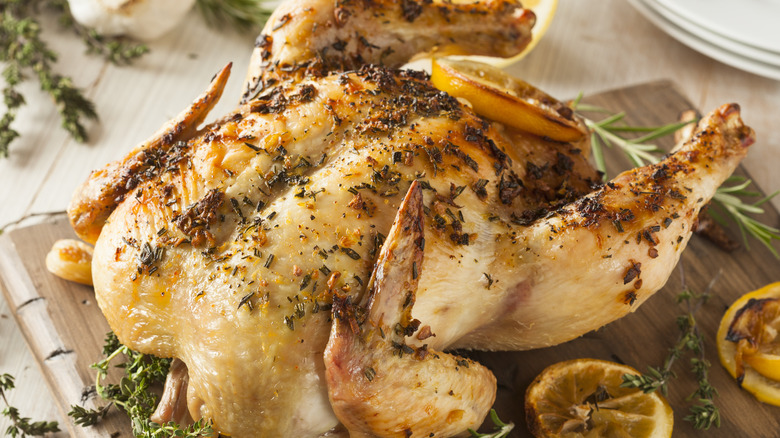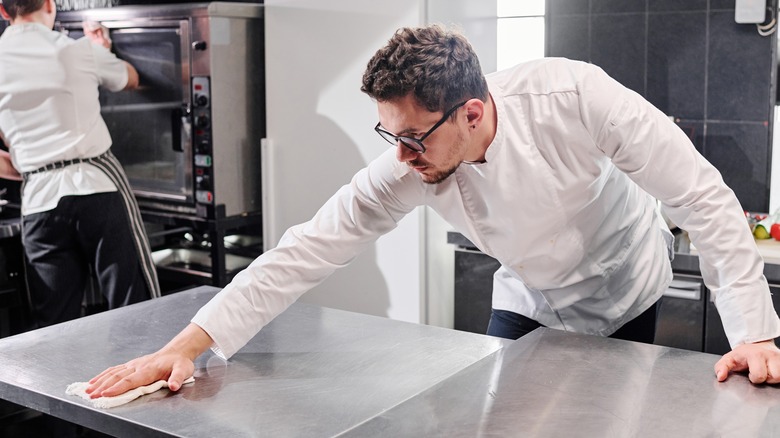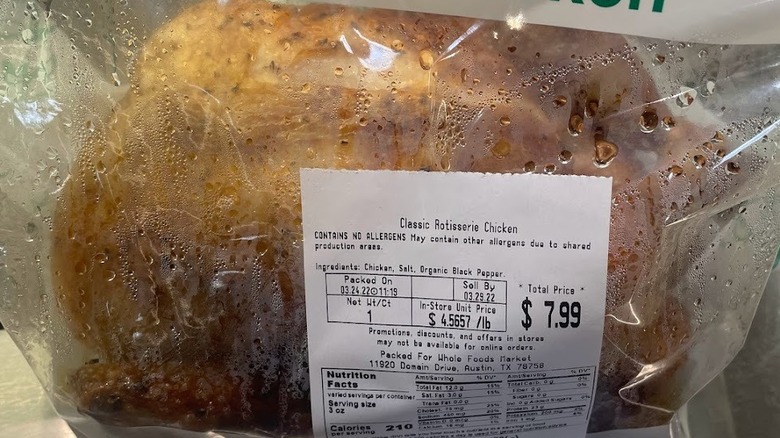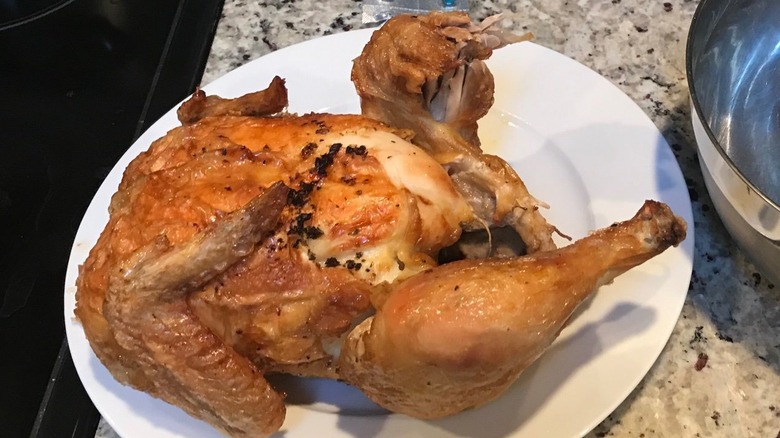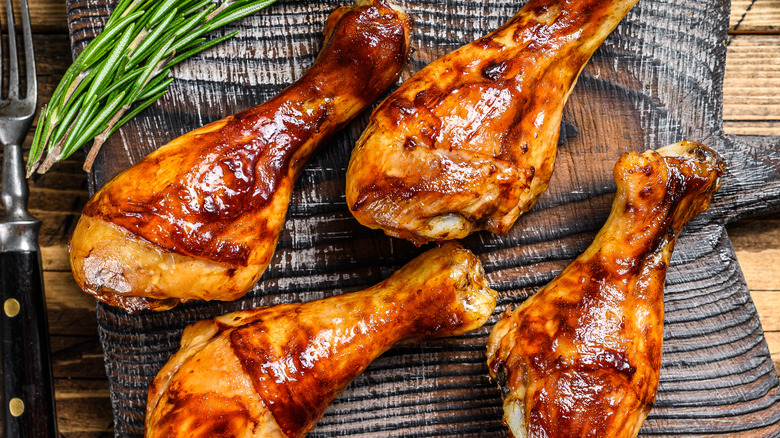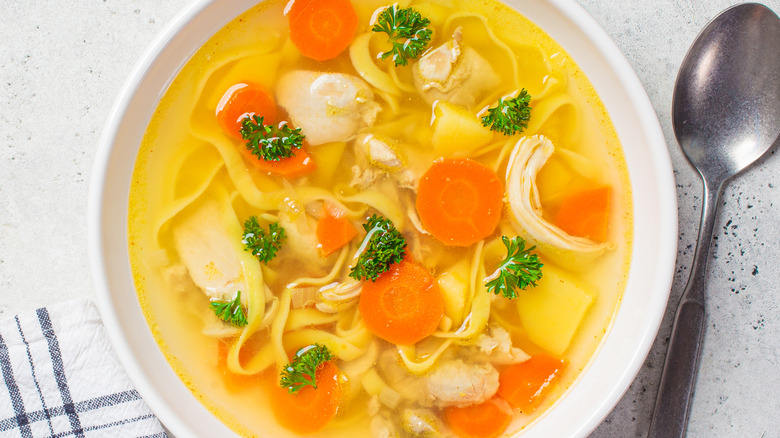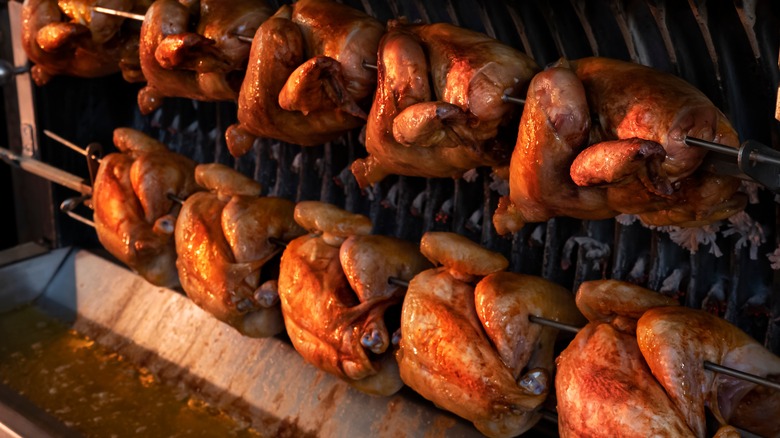How To Pick The Best Grocery Store Rotisserie Chicken
One of our favorite sights at a grocery store is rotisserie chicken roasting to perfection in the kitchen. Costco and Sam's Club are known for their affordable rotisserie chickens, but they certainly aren't the only stores to offer these delicious birds to shoppers. Several grocery stores — from larger chains to smaller, locally-owned businesses — cook their own rotisserie chickens in-store, giving customers fresh food that makes for an incredibly easy dinner.
But if you're new to the rotisserie chicken shopping game, how do you know which chicken to choose, especially if there are several of them waiting in the display case for customers to take them home? As frequent rotisserie chicken shoppers ourselves, we have several tips to help you find your bird to bring home to the dinner table. In this guide, we'll cover important tips to not only ensure you're getting a tasty rotisserie chicken, but also help you determine what chicken is safest and most affordable for you and your family.
Make sure your chicken is held at the right temperature
Sure, you want the juiciest, healthiest, yummiest-looking chicken in the display case. But if that chicken wasn't cooking properly and isn't being held at a safe temperature, it could make you sick. Therefore, the first thing to do before choosing one is scope out the cooking and holding process. According to the USDA, roasted chicken shouldn't be cooked with a temperature lower than 325 degrees Fahrenheit. If you can't see a temperature near the cooking chickens, you can ask a worker what temperature they use.
Then, once the chicken makes it to the display case, the USDA says that it needs to be kept at a temperature of 140 degrees Fahrenheit or higher to be safely out of the food danger zone. Any lower and you run the risk of buying chicken with rapidly growing bacteria. Be sure to save picking up your rotisserie chicken at the end of your shopping trip, too, to prevent it from dropping to unsafe temperatures while you transport it home.
Look for pooling juices
It's normal for some juice to escape rotisserie chicken as they wait for grocery shoppers to choose them. But there's a difference between a few drops of natural juices and pooling juices underneath the chicken.
Usually, some juice escapes from sticking a thermometer into the meat to ensure it's done before putting it on display. That's a good thing. However, juice can also escape when a chicken is plumped before cooking. The plumping process adds a mix of mostly water and saline to chicken to make it bigger, heavier, look more appetizing, and keep it juicy when cooking. When plumped chicken gets cooked, though, most of that liquid escapes, ending up in the bottom of the tray.
Aside from not looking very appetizing, this pooled liquid can make the bottom of your rotisserie chicken very soggy, which defeats the purpose of roasting it to get that crispy, brown skin you expect on this kind of chicken. Some grocery stores use an absorbent pad underneath their rotisserie chickens to absorb any escaping juices, which could help prevent the problem of soggy skin.
Crisp, healthy-looking browned skin is a must
When you're choosing between rotisserie chickens at the grocery store, you probably gravitate more toward those with browned skin, which is a good sign that the skin is crisp and flavorful. But there are a couple of other points to consider with chicken skin that you might not have thought about before.
One is skin shriveling. This can be a sign that a chicken has been held in the display case for a long time. When chicken overstays its welcome in the holding unit, it tends to dry out, resulting in shriveled skin and, most likely, dry meat underneath. Instead, the skin should be relatively smooth and taut.
Another potential problem is uneven skin color. That browned skin you're looking for should be present all over the chicken rather than in just a few places or on one side of the chicken. Uneven skin color can be a sign that rotisserie chicken was cooked longer than the other or that the rotisserie oven was packed too tightly or not turning properly while cooking. Either way, you may end up with unevenly cooked chicken.
Always check the timestamp
Most grocery stores have strict rules about how long they can leave their cooked rotisserie chickens in their display cases. For example, one Redditor, who's also someone who makes rotisserie chickens at their store, says that they aren't allowed to keep their chickens in the case for longer than two hours.
Each store is different, of course, but you don't necessarily need to know the rules for every store. That's because rotisserie chickens typically have a timestamp on them to show customers when they came out of the rotisserie oven. That way, you know how old the chicken is that you're buying and can decide for yourself whether you'd like to wait to buy a fresher one. The timestamps are usually located somewhere on a label, either on top or at the bottom of the plastic container. Whether the chicken is being kept at safe temperatures in the display case is most important. However, chickens that sit for longer than their typical display time could end up drying out over time.
Using it today? Look for a discount tag
It's difficult for stores to predict how much rotisserie chicken their customers want to buy each day, so it's not uncommon for there to be more cooked than necessary. When that happens, the holding units become overloaded with chicken, which isn't good for the store when not enough people want to buy them within the next few hours.
Although some of that chicken usually gets turned into other ready-to-eat items (like chicken salad, chicken sandwiches, or soups), the leftovers might go to waste if they aren't bought. To curb food waste, stores sometimes discount their rotisserie chicken if they're coming close to the end of their expiration time. You'll typically see this marked with a special tag for $1 off or more. In fact, we've seen a few stores discount their rotisserie chickens by $3 or $4, especially if it's close to closing time.
If you plan to use your chicken today or you're going to freeze it, buying discounted rotisserie chicken could save you a lot of money or let you get more chicken for the same price. Just ensure that the cashier rings in your discount when you check out.
Compare their sizes
When it comes to finding the right rotisserie chicken, size matters for many shoppers. However, whether you want a smaller or larger bird comes down to personal preference. Let's consider a few pros and cons of each.
Some customers swear that smaller birds are more flavorful. For instance, this Redditor says, "I always pick a smaller one that's less than normal price. I know everyone likes the big frankenchicken but the small birds are so much more flavorful." And, if you only need chicken for one or two people, a smaller chicken will probably do just fine. Of course, because you're buying less chicken, you might pay less for it if it's priced per pound.
On the other hand, some customers go straight for larger birds, especially if the store you're buying from prices all of its rotisserie chickens the same, regardless of how much they weigh. For example, Costco prices them all at $4.99. So, if you're paying the same amount for a small or large chicken, you might as well grab the bigger one, right? One Redditor does just that: "I look for the one that is pressing against the clear plastic package top. More bang for my buck. Throw it in the fridge for a bit then tear it to pieces." Of course, some people feel that a larger chicken is usually drier because it takes longer to cook. Ultimately, it's your choice — perhaps a comparison test is in your near future?
Pay attention to the ingredient label
Rotisserie chicken from different stores tastes surprisingly different. If you compare rotisserie chicken between Walmart and Costco, for example, you might find that you like the flavor of one more than the other, even if their juiciness and texture are similar.
That's because stores make rotisserie chicken using unique seasoning blends and processes that make their chickens different from the rest. In doing so, the stores hope that customers will prefer their chickens over competing versions. However, some stores may add ingredients to their chickens that you don't like or can't have, such as spices you're allergic to. Although you might not think to read the ingredient label of a rotisserie chicken before you buy it, we recommend doing so to avoid spending your money on something you can't eat.
Also, while some stores plump their chickens before cooking them, others stay away from this practice. Plumped chickens tend to have high sodium content because they're injected with saline. However, heavily seasoned chickens might also have a high sodium level because of added salt to the skin. Either way, it's necessary to check the ingredient label if you're watching your sodium intake.
Scope out the preparation area's cleanliness
Any kitchen that prepares food for the public is supposed to meet cleaning and sanitizing standards. Federal, state, and local agencies can put regulations in place for kitchens and food preparation areas to adhere to. There's no exception for grocery stores that cook ready-to-eat foods in-store, like rotisserie chicken.
It's a good idea for customers to know what to look for in a safe, healthy, and clean kitchen from where they're considering buying a rotisserie chicken. In just a few seconds, you should be able to tell whether the store uses proper cleaning and sanitizing methods to keep your food as safe as possible.
First, if you can see the dishwashing area, see if employees are thoroughly rinsing, scrubbing, and washing the dishes and equipment. After being washed, the dishes should be placed in a sanitizer bath or unit and then allowed to dry. Next, look for consistent cleaning and sanitization of food preparation areas, like counters and cutting boards. Also, uncooked foods should never come near ready-to-eat foods, like fruit and vegetables. Finally, check if the employees are maintaining safe food handling practices, like wearing hairnets and gloves and washing their hands frequently.
Double-check the price
We've bought our fair share of rotisserie chicken from our favorite grocery stores over the years. If there's one thing we can confidently say, it's that mistakes happen. We've seen labels get marked incorrectly, sometimes with printing mishaps that make them illegible and sometimes with pricing mistakes. Labels are there for a reason, so we like to double-check them, especially when it comes to our food.
One thing we always check on rotisserie chicken before buying it is the pricing area on a label. We look for both the per-pound pricing and the final price with stores that label them this way. If stores have a set price, it's still important to check the label's price. It can be easy for workers to accidentally hit the wrong button on a computer when labeling the chicken, and that little mistake could translate into you spending more money on your rotisserie chicken.
The good news is that if you check before buying your bird, you can always ask an employee behind the counter for a new label that reflects the correct pricing. Then, you won't have to worry about trying to get a refund after spotting the price mistake on your receipt.
Examine the legs for splitting
If you've ever roasted a whole chicken in the oven, you've probably witnessed the legs pulling away from the chicken as it nears its cooking time. This isn't usually a bad thing. After all, many people mention that the ultimate goal for their cooked chicken is to have the meat falling off the bones, which tends to mean that the meat is tender and juicy.
That's great if you know that your chicken is right-out-of-the-oven fresh. However, rotisserie chickens can sit in their display cabinets waiting for customers to grab them for a couple of hours. If their legs started splitting from the chicken while cooking, they might sit like that for another hour or two until you buy it. When the legs split from the body, it typically breaks the crispy skin, which acts as a protective layer for the meat underneath. During that time, juices can leak out from the area and the heat lamps could dry out the chicken. Unless the timestamp on a rotisserie chicken is within the last few minutes, you might want to look for birds with their legs still comfortably intact, just to be on the safe side.
Consider what flavors and spices are added
While many grocery stores typically offer plain rotisserie chicken with just a few necessary spices (like salt, pepper, and maybe a little garlic powder), others give customers more options. For example, we've seen a few stores offer barbecue rotisserie chickens or chicken seasoned with spicy, bold cajun flavors. Every once in a while, we even see a lemon rosemary chicken, which is a great change of pace.
While these added flavors can be great if you plan to enjoy your chicken on its own without adding anything to it, they could interfere with your original plans for a rotisserie chicken. For instance, a barbecue chicken won't work so well if you planned on shredding that chicken for soup or sandwiches.
This is another reason to pay close attention to the labels on rotisserie chicken before buying them. Fortunately, many stores mark their flavored or seasoned chickens clearly, sometimes even placing them in a separate holding cabinet from their regular chickens. You might also want to learn your store's schedule if you're looking for a specific flavor, as some rotate the flavors they set out each day.
You don't always need to avoid the older chickens
Are you buying rotisserie chicken to make your casserole or soup dish easier? Rotisserie chicken is incredibly convenient for no-fuss dinners that call for shredded chicken. Pick one up from the store, bring it home, and spend a few minutes shredding it in your kitchen to have dinner on the table as quickly as possible.
When it comes to meals that use shredded chicken, getting the freshest bird isn't usually necessary. If you're going to add the chicken into other ingredients, there's a good chance that the sauces and liquids you use in your dish will keep the chicken from drying out, even if it's been sitting under a heat lamp for a few hours at the store. That means you don't have to be as picky when choosing your rotisserie chicken.
As a bonus, you might even be able to save a few dollars if you can find soon-to-expire rotisserie chicken that the store is selling at a discount.
Consider waiting for a fresh one if you want to eat it soon
Have you ever walked up to the rotisserie chicken counter and seen people waiting, even though there are several chickens waiting to be purchased? There are no rules saying you can't wait around for a hot, fresh rotisserie chicken if that's what you prefer. And, if you're planning to eat it once you get home, it might be a good idea to wait on that fresh chicken to ensure that it's still fresh and hot when you're ready to eat.
Just don't be someone who grabs chickens from the hot case, does the rest of your shopping, and then comes back to trade those chickens for fresh ones when you see them coming out of the rotisserie oven. When customers do this, the employees have to throw the older chicken away or repurpose them, essentially wasting food that other customers could have bought. One Redditor explains, "My warehouse has recently had a surge of members who take grab over 10 chickens, shop around some more, then trade them all for fresh ones. At that point they're an unsafe temperature to sell, and I have to throw them into the bone barrel that is superheated into animal food slop. I end up running out of chickens and having a ridiculous amount of waste."
In short, waiting for fresh-off-the-rotisserie chicken is acceptable, but wasting food by chicken-swapping is definitely not a good habit to start.
